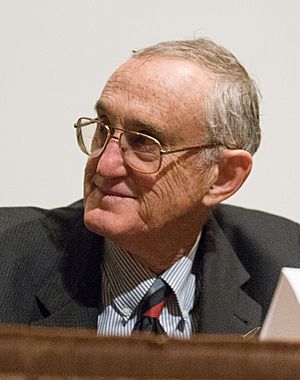David Lee (physicist) facts for kids
Quick facts for kids
David Morris Lee
|
|
|---|---|

David Morris Lee in 2007
|
|
| Born | January 20, 1931 |
| Education | Harvard University (BA) University of Connecticut (MA) Yale University (PhD) |
| Spouse(s) | Dana (2 children) |
| Awards | Nobel Prize in Physics (1996) Oliver Buckley Prize (1981) Simon Memorial Prize (1976) Buckley Prize (1970) |
| Scientific career | |
| Fields | Physics |
| Institutions | Cornell University Texas A&M University (2009-present) |
| Doctoral advisor | Henry A. Fairbank |
David Morris Lee is an American physicist born on January 20, 1931. He won the Nobel Prize in Physics in 1996. He shared this award with Robert C. Richardson and Douglas Osheroff. They were recognized for finding something amazing: "superfluidity in helium-3."
Today, Dr. Lee is a respected physics professor. He is a professor emeritus at Cornell University. He is also a distinguished professor at Texas A&M University.
Contents
About David Lee's Early Life
David Lee grew up in Rye, New York. His parents were Annette and Marvin Lee. His mother was a teacher, and his father was an electrical engineer. David graduated from Harvard University in 1952. After that, he served in the U.S. Army for almost two years.
David Lee's Education Journey
After his time in the army, David Lee continued his studies. He earned a master's degree from the University of Connecticut. In 1955, he joined the PhD program at Yale University. There, he worked with Professor Henry A. Fairbank. He focused on studying materials at very cold temperatures. His research was about liquid helium-3.
Starting a Career and Family
After finishing his PhD in 1959, Lee started working at Cornell University. He helped set up a new lab there. It was called the Laboratory of Atomic and Solid State Physics. Soon after, he met Dana, who became his wife. They had two sons together. In 2009, Dr. Lee moved his lab to Texas A&M University.
David Lee's Amazing Discoveries
The work that earned David Lee his Nobel Prize happened in the early 1970s. He worked with Robert C. Richardson and a student named Doug Osheroff. They used a special cooling device called a Pomeranchuk cell. Their goal was to study helium-3 at extremely cold temperatures. These temperatures were just a tiny bit above absolute zero. Absolute zero is the coldest possible temperature.
Finding Superfluid Helium-3
During their experiments, they noticed something unexpected. They saw changes in their measurements. They eventually realized these changes were "phase transitions." This means the helium-3 was changing into a new state. It became a "superfluid" phase. A superfluid is a liquid that can flow without any friction. It's like it has no stickiness at all! This discovery was very important. Lee, Richardson, and Osheroff won the Nobel Prize for it in 1996.
Other Important Research
David Lee also studied other things in low-temperature physics. He looked at liquid, solid, and superfluid helium. This included helium-4, helium-3, and mixtures of both. Some of his other discoveries include:
- How solid helium-3 can become "antiferromagnetic." This is a type of magnetic ordering.
- "Nuclear spin waves" in hydrogen gas. He worked on this with Jack H. Freed.
- The "tri-critical point" in liquid helium mixtures. He worked on this with John Reppy.
His research group at Cornell studied "impurity-helium solids." These are solids with tiny bits of other materials inside helium.
Awards and Recognition
Besides the Nobel Prize, David Lee has received other honors. In 1976, he won the Sir Francis Simon Memorial Prize. This award is from the British Institute of Physics. In 1981, he received the Oliver Buckley Prize from the American Physical Society. He shared this with Doug Osheroff and Robert Richardson. This was also for their work on superfluid helium-3. In 1997, he received the Golden Plate Award. This award is from the American Academy of Achievement.
David Lee is also a member of important science groups. These include the National Academy of Sciences and the American Academy of Arts and Sciences. He continues to teach physics and do research at Texas A&M University.
See also
 In Spanish: David Morris Lee para niños
In Spanish: David Morris Lee para niños
- List of Jewish Nobel laureates
- Timeline of low-temperature technology

